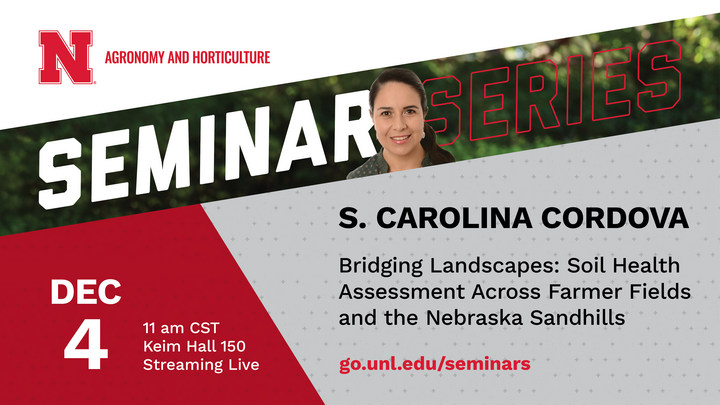Spring Seminar Series 2026 coming in February!
Seminars will be in person, streamed live and recorded at 11 a.m. CST/CDT on Thursdays in Keim Hall, Room 150, unless otherwise noted.
Join seminar via Zoom at: https://go.unl.edu/agrohortseminar
Sept. 4, 2025
Integrating Testing Optimization Frameworks into Soybean Breeding at UNL
ARTHUR BERNARDELI
Ph.D. Candidate in Plant Breeding and Genetics, Department of Agronomy and Horticulture, University of Nebraska–Lincoln
This presentation highlights innovations to enhance soybean breeding efficiency at UNL. Topics include optimizing multi-environment trials through implementing genomic sparse testing designs, TPE and hub definitions, advancing drone-based phenotyping for maturity and software development to streamline analytical pipelines. Together, these approaches strengthen decision-making, improve resource allocation and accelerate genetic gain.
Sept. 11, 2025
In the Name of National Security: Front Line Science for the Farm, Table and in a Tube
MEGHAN JACKSON
Director for Food, Agriculture & Environment Security, National Strategic Research Institute, University of Nebraska
What do flying cows have to do with national security? And how does your research on severe weather protect our country? Take a walk through history to discover how diseases, environmental research and groundbreaking ideas crucial for national defense transform your every day.
Sept. 18, 2025
Decisions on the Prairie: How People Shape Rangeland Futures
GWENDŴR MEREDITH
Assistant Professor, Department of Agronomy and Horticulture, and School of Natural Resources, University of Nebraska–Lincoln
What do ranchers’ decisions have to do with healthy prairies? And how does social science shape the future of our food and open spaces? Explore how research on people, prairies and partnerships reveals surprising connections that turn science into public value on working rangelands.
Sept. 25, 2025
Where to go with GMOs? The Next Generation of Agricultural Biotechnology
NATHANIEL BUTLER
Director, Plant Transformation Core Research Facility, Assistant Professor, Department of Agronomy and Horticulture, University of Nebraska–Lincoln
It has been over 40 years since the first GMO plant product, the Flavr Savr tomato, was released, and only a handful have come since — so what now? This presentation will present current approaches to getting genetically engineered plant products to market and the opportunities and challenges to the industry.
Oct. 2, 2025
Using Theories of Power to Navigate Persistent Problems: Exploring Cases of Climate-Smart Agriculture in California and Agricultural Diversification in the Corn Belt
BRENNAN RADULSKI
Postdoctoral Research Associate, Department of Horticulture and Landscape Architecture, Purdue University
This presentation will discuss how social science research can provide a deep understanding of complex and persistent problems by applying theories of power to analyze and interpret social science data. The presentation will draw from cases exploring food system audiences’ perspectives of 1) the efficacy of California government climate-smart agriculture programs for farmers and 2) the policy and market challenges and opportunities related to diversifying farming systems, the landscape and markets in three Corn Belt states.
Oct. 9, 2025
Beneficial Bug Bale Project: An Eloquent Strategy for Managing a 100-year Pest of Wheat
JEFF BRADSHAW
Professor of Entomology, Director of Plant Health, University of Nebraska–Lincoln
The wheat stem sawfly, Cephus cinctus, has been a major pest of wheat in North America for over 100 years. Recent work by a large group of scientists and stakeholders are evaluating the success of a unique biological control strategy for the conservation and augmentative release of braconid parasitoids for the management of the wheat stem sawfly.
Farmers as Science Advocates: Cases for Creative Engagement
RACHAEL WHITEHAIR
Director of Innovation & Stewardship, Nebraska Corn Board
Producers across the nation are heavily engaged in research and science communication, contributing to the advancement of the agriculture industry and its overall sustainability. This presentation takes a closer look at some of the key models utilized by commodity organizations to grow science advocacy and involvement among farmers.
Nov. 13, 2025
Utilizing Extension to Answer Turfgrass Science Questions for Nebraskans and Beyond
AMANDA FOLCK
Assistant Extension Educator in Turfgrass Management, Department of Agronomy and Horticulture, University of Nebraska-Lincoln
This seminar will show how Folck developed her work in extension to utilize the answers to turfgrass science questions for Nebraskans and beyond. This is based on examples of her current collaborations in various outreach/engagement, teaching and applied research with extension.
Nov. 20, 2025
Experiential Plant Breeding Training in the UNL Barley Program
RAFAEL BLEY COTTICA
Graduate Research Assistant, Department of Agronomy and Horticulture, University of Nebraska–Lincoln
KATHERINE FRELS
Assistant Professor, Department of Agronomy and Horticulture, University of Nebraska–Lincoln
The UNL barley program does more than release elite varieties. Led by graduate students, it serves as a training ground for the next generation of breeders. They gain critical experience making high-stakes decisions, ensuring they are ready to lead their own programs immediately upon graduation.
Dec. 4, 2025

Bridging Landscapes: Soil Health Assessment Across Farmer Fields and the Nebraska Sandhills
S. CAROLINA CORDOVA
Assistant Professor, Statewide Soil Health Specialist, Department of Agronomy and Horticulture, University of Nebraska–Lincoln
This presentation explores soil health assessment methods applied in both Nebraska farmer fields and the unique Sandhills landscape of National Park Halsey. Discover how on-farm evaluations and research in protected areas together enhance our understanding of soil function, sustainability and management practices across diverse ecosystems.